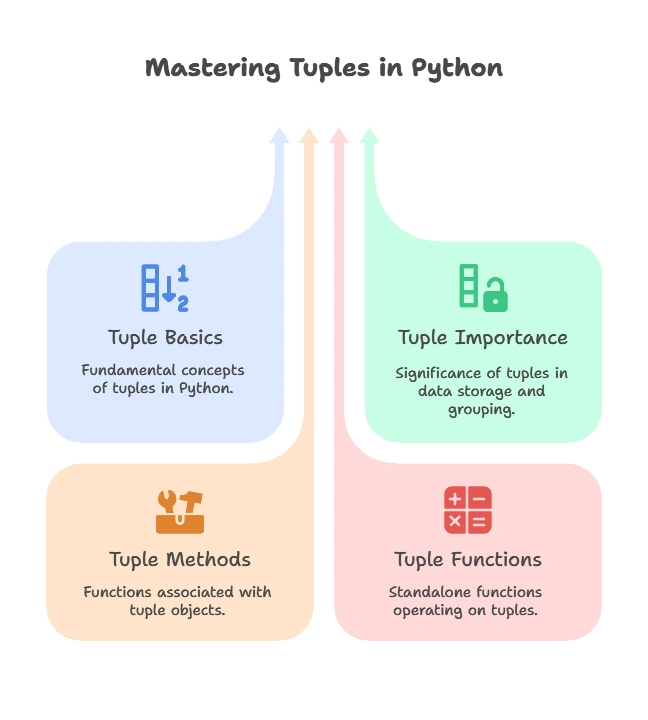Tuple Methods in Python
Tuples Methods are immutable sequences of elements, commonly used for storing collections of related data. In this topic, we'll explore various tuple methods that enable us to manipulate and work with tuples efficiently. From basic operations like index() and count() to more advanced techniques for tuple manipulation and conversion.
Understanding Tuples in Python
In this section, we’ll cover the basics of tuples in Python and understand their significance in programming.
What are Tuples?
Tuples in Python are ordered collections of elements enclosed within parentheses (). Unlike lists, tuples are immutable, meaning their elements cannot be changed after creation.
Why Tuples are Important?
Tuples are used to store data that should not be changed, such as coordinates, database records, or configuration settings. They provide a convenient way to group related data together.
Tuple Methods vs. Tuple Functions
Tuple methods are functions that belong to the tuple object and are called using dot notation (tuple.method()), while tuple functions are standalone functions that operate on tuples and are called with the tuple as an argument (function(tuple)).

Basic Tuple Methods
In this section, we’ll explore some of the most commonly used basic tuple methods in Python.
index() Method
The index() method returns the index of the first occurrence of a specified value in the tuple.
my_tuple = (1, 2, 3, 4, 2)
index = my_tuple.index(2)
print(index) # Output: 1
Explanation:
- The
index(2)method returns the index of the first occurrence of the value2in the tuplemy_tuple.
count() Method
The count() method returns the number of occurrences of a specified value in the tuple.
my_tuple = (1, 2, 3, 4, 2)
count = my_tuple.count(2)
print(count) # Output: 2
Explanation:
- The
count(2)method returns the number of occurrences of the value2in the tuplemy_tuple.
Advanced Tuple Methods
In this section, we’ll explore advanced tuple methods that offer powerful functionalities for tuple manipulation and conversion.
sorted() Method
The sorted() method returns a new sorted list from the elements of the tuple.
my_tuple = (3, 1, 4, 1, 5, 9, 2, 6, 5)
sorted_list = sorted(my_tuple)
print(sorted_list) # Output: [1, 1, 2, 3, 4, 5, 5, 6, 9]
Explanation:
- The
sorted()method sorts the elements of the tuplemy_tupleand returns a new sorted listsorted_list.
tuple() Function
The tuple() function converts an iterable (such as a list) into a tuple.
my_list = [1, 2, 3, 4, 5]
my_tuple = tuple(my_list)
print(my_tuple) # Output: (1, 2, 3, 4, 5)
Explanation:
- The
tuple(my_list)function converts the listmy_listinto a tuplemy_tuple.
Tuple Packing and Unpacking
In this section, we’ll explore tuple packing and unpacking, which are essential concepts in Python for efficiently working with tuples.
Tuple Packing
Tuple packing is the process of creating a tuple without using parentheses. Python automatically packs the values into a tuple.
x = 10
y = 20
my_tuple = x, y
print(my_tuple) # Output: (10, 20)
Explanation:
- The variables
xandyare packed into a tuplemy_tuplewithout using parentheses.
Tuple Unpacking
Tuple unpacking is the process of extracting values from a tuple into individual variables.
my_tuple = (10, 20)
x, y = my_tuple
print(x) # Output: 10
print(y) # Output: 20
Explanation:
- The values
(10, 20)are unpacked from the tuplemy_tupleinto variablesxandy.
We've explored a comprehensive range of tuple methods and concepts in Python, covering basic operations, advanced manipulation, sorting, packing, and unpacking functionalities. Tuples are immutable data structures that offer efficient storage and retrieval of related data elements.
By mastering these tuple methods and concepts, you gain the ability to efficiently handle various tasks involving tuple manipulation, conversion, and efficient data storage. Whether you're indexing elements, counting occurrences, sorting tuples, or packing and unpacking values, Python's rich set of tuple methods and concepts provides powerful tools to accomplish your programming goals. Happy Coding!❤️
